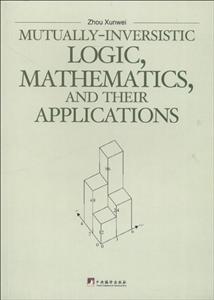-
>
宇宙、量子和人类心灵
-
>
(精)BBC地球故事系列-星际旅行
-
>
从一到无穷大
-
>
图说相对论(32开平装)
-
>
一本有趣又有料的化学书
-
>
刘薰宇的数学三书:原来数学可以这样学全3册
-
>
光学零件制造工艺学
互逆主义逻辑、数学和它们的应用:英文版 版权信息
- ISBN:9787511716118
- 条形码:9787511716118 ; 978-7-5117-1611-8
- 装帧:一般胶版纸
- 册数:暂无
- 重量:暂无
- 所属分类:>
互逆主义逻辑、数学和它们的应用:英文版 内容简介
Since then, I have been constructing mutually-inversistic mathematical logic. Now, itis fully fledged. It includes mutually-inversistic logic, mutually-inversistic mathematics,and their applications. Mutually-inversistic logic includes two calculi and four theoriesof mutual-inversism, mutually-inversistic granular computing, unified logics. Mutually-inversistic mathematics includes mutually-inversistic analytic geometry, mutually-inversistic mathematical analysis, mutually-inversistic abstract algebra, universal matrix.Applications include logic programming (see Part 4), automated theorem proving, planningand scheduling, database, semantic network, expert system, program verification, naturallanguage processing, hardware verification, machine learning, data mining, data warehouse,program refinement, many-valued computer, modern control theory, etc...
互逆主义逻辑、数学和它们的应用:英文版 目录
Part 1 Mutually-inversistic logical calculus
Chapter 1 Fundaments of predicate calculus
1.1 Material implication vs. mutually inverse implication
1.2 Formation ofterms and propositions
1.3 Simple-complexcomposition
1.4 Zeroth-level predicate calculus
Chapter 2 Human cognitive processes and basic principles of mutually-inversistic logic
2.1 Mutually inverse special propositions vs. mutually inverse general propositions
2.2 Unary cognitive processes
2.3 Binary cognitive processes
2.4 Man's cognitive route
2.5 Classification ofcognitive processes
2.6 Inductive composition vs. decomposition
2.7 The principle ofinductive composition, the principle ofdecomposition, and the principle of mutual inverseness between inductive composition and decomposition
2.8 Truth tables ofinductive composition and decomposition for the connection operators
2.9 Mutually inverse diagrams for the connection operators
2.10 The principle ofmeaningfulness and meaninglessness duality for the distinguished propositions
Chapter 3 First-level single quasi-predicate calculus
3.1 Meaningless and meaningful first-order single empirical or mathematical connection propositions
3.2 Free and bound first-order single empirical or mathematical connection propostions
3.3 First-levelexplicitinductivecomposition
3.4 First-levelimplicitinductivecomposition
3.5 Contradictorypropositions
3.6 First-leveldecomposition
3.7 Quasi-logicalconnectionpropositions
3.8 The decomposition system offirst-level single quasi-predicate calculus
Chapter 4 Second-level single quasi-predicate calculus
4.1 Meaningless and meaningful second-order single logical connection propositions
4.2 Free and bound second-order single logical connection propositions
4.3 Second-levelexplicitinductivecomposition
4.4 Second-levelimplicitinductivecomposition
4.5 Second-leveldecomposition
4.6 Quasi-transcendentlogicalconnectionpropositions
4.7 Knowledge-cognitionscience
4.8 The decomposition system of second-level single quasi-predicate calculus
Chapter 5 First-level multiple predicate calculus
5.1 Property fact proposition segments vs. non-property fact propositions
5.2 Mutually inverse multiple diagrams
5.3 Success diagrams vs. failure diagrams
5.4 Least success diagrams
5.5 Proposition chains and property proposition segment chains
5.6 Multiple empirical or mathematical connection propositions
5.7 Meaningful and bound multiple empirical or mathematical connection propositions
5.8 Mutually inverse multiple diagrams for multiple empmcal or mathematical connection propositions
5.9 Proposition chains, property proposition segment chains, and least success diagrams of multiple empirical or mathematical connection propositions
2.10 Decomposition system offirst-levelmultiple predicate calculus
Chapter 6 Second-level multiple predicate calculus
Chapter 7 Mutually-inversistic propositional calculus
Part 2 Mutually-inversistic set theory
Chapter 8 Fundamentals of mutually-inversistic set theory
Chapter 9 The Main
Chapter 10 The auxiliary
Part 3 Mutually-inversistic proof theory vs mutually-inversistic model theory
Chapter 11 Proof theory vs model theory
Chapter 12 Mutually-inversistic proof theory
Chapter 13 Mutually-inversistic model theory
Part 4 Mutually-inversistic recursion theory
Chapter 14 Mutually-inversistic recursion theory
Part 5 Mutually-inversistic granular computing
Chapter 15 Mutually-inversistic fuzzy logic based granular computing
Chapter 16 Mutually-inversistic rough set based granular computing
Chapter 17 Unified logics
Part 7 Mutually-inversistic analytic geometry
Chapter 18 Mutually-inversistic analytic geometry
Part 8 Mutually-inversistic mathematical analysis
Chapter 19 Double-sided discrete calculus
Chapter 20 Single-sided discrete calculus
Chapter 21 Unified calculus
Part 9 Mutually-inversistic abstract algebra
Chapter 22 Auxiliary algebras
Chapter 23 Main-auxiliary algebras
Part 10 Universal matrices
Chapter 24 Universal matrices
Part 11 Applications of decomposition
Chapter 25 Inference rule systems vs mutually-inversistic automated decomposition systems
Chapter 26 Mutually-inversistic relational databases
Chapter 27 Mutually-inversistic planning and scheduling
Chapter 28 Mutually-Inversistic Semantic Network
Chapter 29 Mutually-inversistic expert systems
Chapter 30 Transformation of second-level inference rule systems into second-level automated decomposition systems
Chapter 31 Applications of First-Level Hypothetical Inference
Chapter 32 Axiomatic systems brought into mutually-inversistic automated decomposition systems
Part 12 Applications of implicit inductive compositions
Chapter 33 Applications of implicit inductive compositions
Part 13 Applications of explicit inductive composition
Chapter 34 Mutually-inversistic machine learning
Chapter 35 Multiple connection operators association rule mining
Chapter 36 Mutually-inversistic program refinement
Part 14 Applications ofmutually-inversistic mathematics
Chapter 37 Applications of universal matrix
Chapter 38 Mutually-inversistic many-valued computer
Chapter 39 Applications of mutually-inversistic mathematical analysis
References
- >
上帝之肋:男人的真实旅程
上帝之肋:男人的真实旅程
¥19.3¥35.0 - >
朝闻道
朝闻道
¥9.0¥23.8 - >
莉莉和章鱼
莉莉和章鱼
¥16.0¥42.0 - >
龙榆生:词曲概论/大家小书
龙榆生:词曲概论/大家小书
¥9.1¥24.0 - >
回忆爱玛侬
回忆爱玛侬
¥12.5¥32.8 - >
经典常谈
经典常谈
¥22.7¥39.8 - >
我与地坛
我与地坛
¥16.8¥28.0 - >
伯纳黛特,你要去哪(2021新版)
伯纳黛特,你要去哪(2021新版)
¥20.4¥49.8
-
时间简史-普及版
¥16.3¥38 -
数学的魅力;初等数学概念演绎
¥10.8¥22 -
图说相对论(32开平装)
¥14.7¥46 -
刘薰宇的数学三书:原来数学可以这样学全3册
¥35.4¥118 -
中职对口升学数学复习指导
¥23.1¥30 -
高等数学基础
¥31.5¥45















